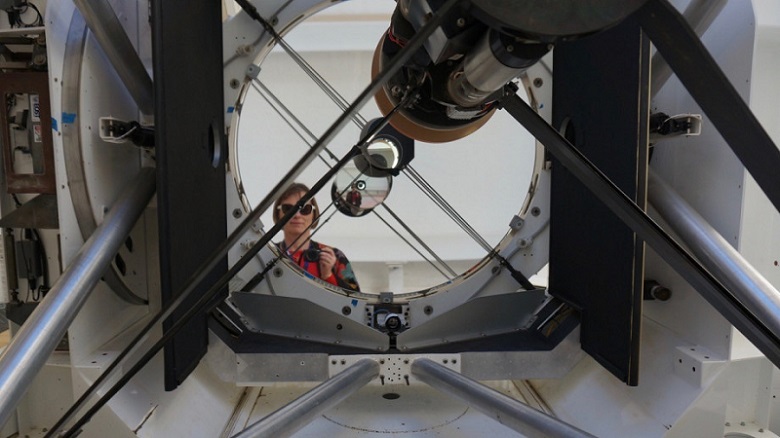
Adaptive Optics Keep an Eye on Space Junk
CANBERRA, Australia, May 12, 2021 — Researchers at Australian National University (ANU) have employed an artificial guide star to bring objects orbiting Earth into focus. The approach may help mitigate risks from space debris.
The guide star laser is a tool in adaptive optics, a field that eliminates the haziness caused by turbulence in the atmosphere. The laser is fired into space and illuminates atoms within the atmosphere. A wavefront sensor measures the level of atmospheric distortion, which then sends a signal to correct the angle of a deformable mirror.
In this case, an orange laser is used, which illuminates sodium atoms in the mesosphere and thermosphere.

Australian National University instrument scientist Celine d’Orgeville stands in front of the 1.8-m telescope at Mount Stromlo Observatory where her image is reflected an infinite amount of times by the two telescope mirrors. Courtesy of Celine d’Orgeville, ANU.
The technique is common for studying stars, galaxies, and planets, but studying objects in the atmosphere poses certain challenges. In looking at something like the International Space Station at an altitude of 400 km, the level of atmospheric turbulence appears to change much more rapidly. The ISS travels at about 8 km/s and completes an orbit every hour and a half, significantly faster than the apparent motion of the sun and stars, which take a day to circle overhead due to Earth’s rotation. When tracking a satellite, the adaptive optics system must make corrections 10 to 20 times faster than it would when observing astronomical objects.
The system employed at ANU’s Mount Stromlo Observatory is able to guide a second, more powerful infrared laser beam through the atmosphere to precisely track space debris, or in some cases move it out of the way to avoid collisions.
Extremely Large Telescope
The Extremely Large Telescope (ELT) being built in the Chilean Atacama Desert will employ a similar technology, though on a much larger scale. Toptica Projects GmbH recently announced it had delivered its first guide star laser for the ELT. It is the first of many guide star laser systems to be employed by the ELT, which may use up to eight.
The systems provided by Toptica are based on those being used for the Very Large Telescope’s adaptive optics system. That system has been used since 2016 as part of the Adaptive Optics Facility; it has shown significant improvements in sharpness, a Toptica press release said.
The ELT is expected to be completed in 2025 and will observe astronomical phenomena ranging from black holes to some of the youngest observable galaxies in the distant universe.
/Buyers_Guide/Toptica_Photonics_AG/c15102